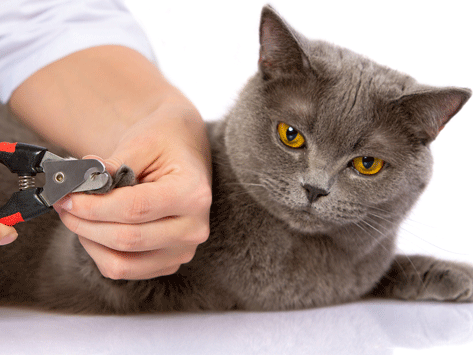Effective vs. Ineffective Cat Grooming
June 4th, 2018

We all know how naturally clean cats are and how they spend hours grooming themselves. For the most part, cats can take care of themselves well, but there are times they’ll need a little help!
The Importance of Grooming
Grooming can be a special bonding time, and when done right, can be enjoyable for both you and your feline friend. With regular grooming, you’ll be able to recognize what’s normal and when something isn’t right. It is an excellent opportunity to check for any parasites or abnormalities, such as lumps, bumps, bald patches, or sores. If you find anything of concern, call your veterinarian to determine if your cat needs a check-up.
Trimming Your Cat’s Claws
It’s always a good idea to get your cat used to having their paws touched and massaged as a part of your time together.
What to do: Make sure your furry friend is relaxed and happy before starting. Apply gentle pressure to paw to expose the claws. Using cat nail clippers, snip the top white tip of the nail, just before the point where it begins to curl. After each nail trim, reward your cat with a tasty treat.
What not to do: Avoid clipping the pink part of the nail which may bleed if cut. Don’t lose your temper or yell at your cat to stay in place. Instead, calm your kitty down before proceeding, or stop the process altogether and continue at a later time.
Brushing Your Cat
Regular brushing sessions will remove dirt, spread natural oils throughout the coat, and prevent tangles. Long haired cat breeds will typically need more brushing.
What to do: Use a metal comb to work through the fur from head to tail. Use a bristle or a rubber brush to remove dead or loose hair. Be very gentle around the chest and belly. End your brushing with a rub or treat. If you find mats you cannot remove, call your veterinarian for advice.
What not to do: Avoid brushing against the direction of your cat’s coat. Never rip off mats or tangles with the brush. It will hurt, and your kitty will come to mistrust both you and the brushing process. Never snip mats of with scissors – you can easily you’re your cat’s delicate skin.
Bathing Your Cat
Cats will usually clean themselves. However, there are the rare occasions when your furry friend could become dirty; in some cases, pet parents are allergic to their furry friends, and need to bathe their cats to minimize their allergies. Most cats hate bathing and may find the process stressful.
What to do: Fill a sink or bathtub with 3 to 4 inches of lukewarm water. Pour water to wet the hair and use a cat-safe shampoo to lather from head to tail gently. Rinse thoroughly to avoid irritating the skin with residue. Conclude the bath time with gently wiping your kitty’s face with a damp cloth. Dry your cat using a big, warm towel and stay away from drafts. Reward good behavior with praise, affection, and treats.
What not to do: Do not apply shampoo to your cat’s face – a damp cloth should do. Never use human shampoos on your kitty. Make sure to avoid dunking or getting water in the eyes, ears, or nose.
We Are All About Cats!
Our experienced and caring team at All About Cats Veterinary Hospital is here to provide you with information and advice about giving your pet the best possible care. We love our feline friends because after all, we are all about cats!
Recent Posts
-
Summer Safety Tips for Cat Owners
July 11th, 2024
-
The ABCs of Cat Vaccinations – What Every Cat Owner Should Know
June 5th, 2024
-
Preparing for Travel With or Without Your Feline Friend
May 3rd, 2024
-
How to Feed Cats in a Multiple-Cat Household
April 8th, 2024
-
8 Tips to Get Your Cat in a Carrier
March 5th, 2024
-
Help, My Cat’s Breath Smells!
February 5th, 2024
-
A Quick Guide to Coping with Cat Emergencies
January 8th, 2024
-
Traveling for the Holidays? 6 Things to Do Before Leaving Your Cat
December 14th, 2023
-
What Is Catnip and Is It Safe for Your Cat?
November 2nd, 2023
-
5 Tips for New Cat Owners
October 5th, 2023
-
How Often Should My Cat Have a Health Check?
September 7th, 2023
-
Cat Hairballs – What Do I Need to Know?
August 4th, 2023
-
How to Play with Your Cat: Fun Cat Activities
July 4th, 2023
-
What to Know About Your Cat’s Surgery
June 10th, 2023
-
Licensed Veterinary Technician or Technician Assistant Wanted (Full time or Part time)
May 15th, 2023
-
Why, Oh Why, Does My Cat Hate Water?
May 9th, 2023
-
What’s Wrong with My Cat? Benefits of Whole-Body Radiology
April 5th, 2023
-
Should I Feed My Cat a Grain-Free Diet?
March 6th, 2023
-
Smelly Cat, Smelly Cat – Causes of Feline Odors
February 22nd, 2023
-
5 Ways to Reduce Cat Shedding
January 3rd, 2023
-
Your Cat’s Holiday Stress – How to Help
December 6th, 2022
-
Pet Cancer Awareness Month: Warning Signs to Look Out For
November 2nd, 2022
-
10 Halloween Safety Tips for Cat Owners
October 3rd, 2022
-
Why Is My Cat So Active at Night?
September 7th, 2022
-
Should I Really Microchip My Cat?
August 9th, 2022
-
Ways to Keep Your Cat Safe and Cool This Summer
July 1st, 2022
-
10 Fascinating Facts About Persian Cats
June 1st, 2022
-
How to Correctly Transition Cat Foods
May 6th, 2022
-
What Your Cat’s Tail Is Secretly Trying to Tell You
April 5th, 2022
-
6 Common Household Items That Are Poisonous to Cats
March 1st, 2022
-
How Do I Know if My Cat Needs Dental Surgery?
February 16th, 2022
-
How to Safely Introduce Your Cat to Your New Baby
January 11th, 2022
-
Giving a Cat as a Christmas Gift: How to Do It Responsibly
December 6th, 2021
-
5 Thanksgiving Foods That Are Toxic to Cats
November 5th, 2021
-
Is My Kitty Depressed? Signs to Look For in a Sad Cat
October 7th, 2021
-
Training Tips for New Kitten Owners
September 7th, 2021
-
Taking Your Cat to the Vet: How to Make It a Stress-Free Experience
August 6th, 2021
-
The Origins and History of the Tabby Cat
July 13th, 2021
-
We are hiring a Veterinary Technician!
July 12th, 2021
-
Kitty Claw Control: How and When to Cut Your Cat’s Nails
June 7th, 2021














